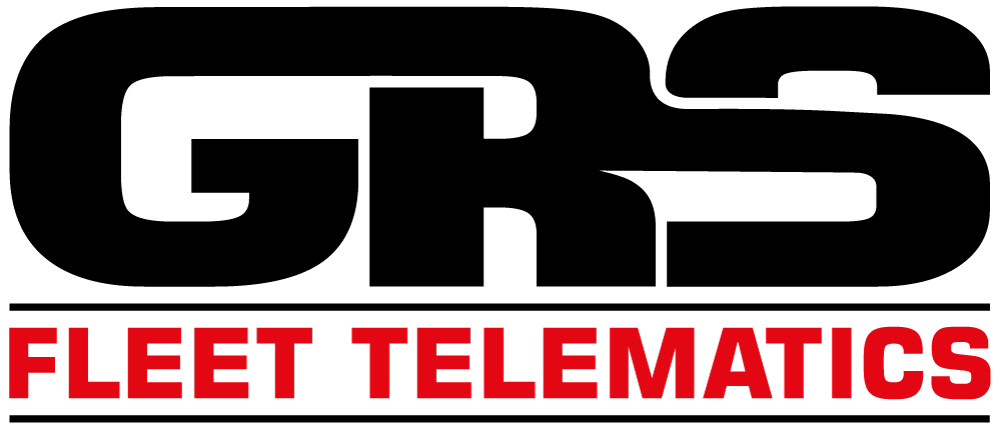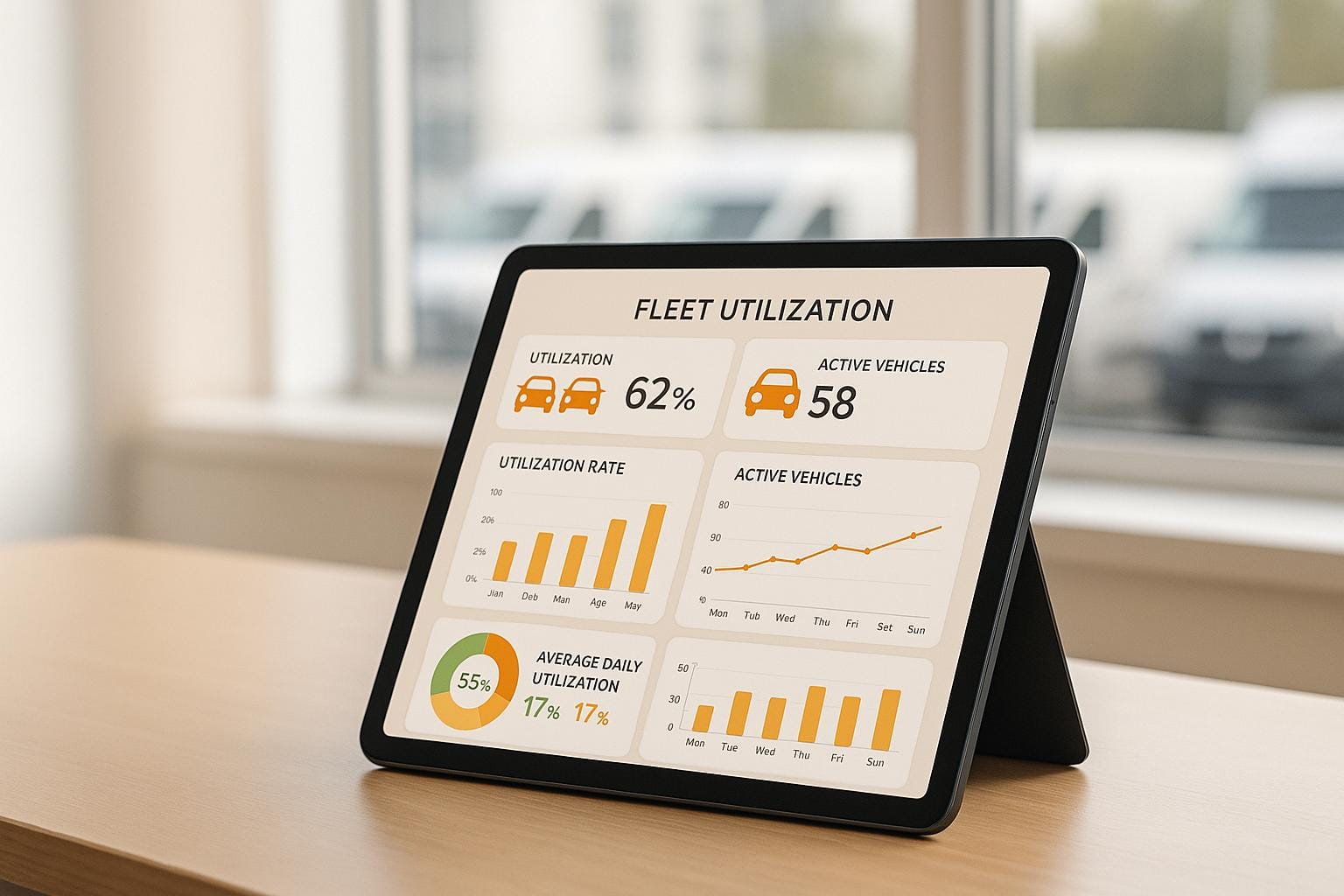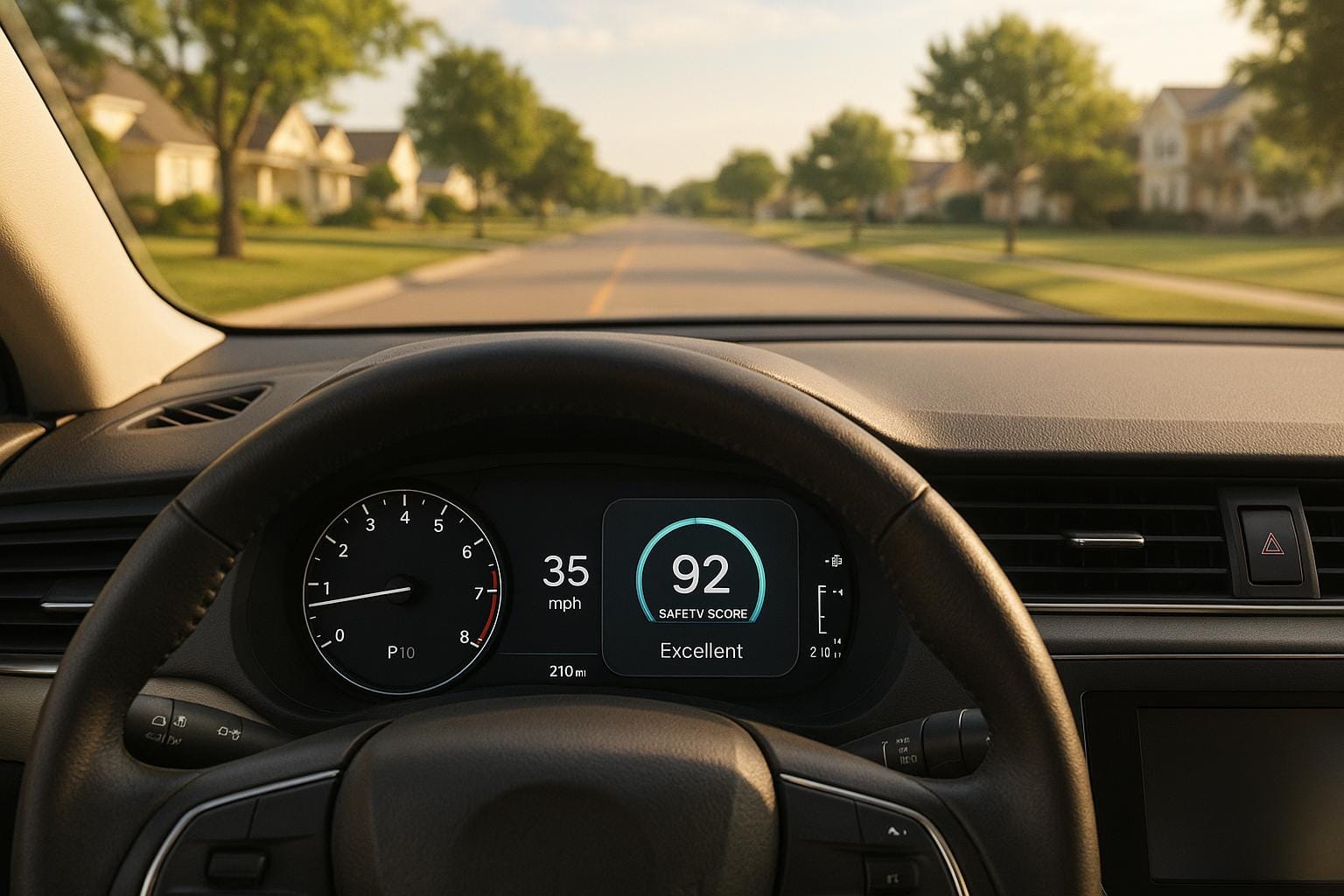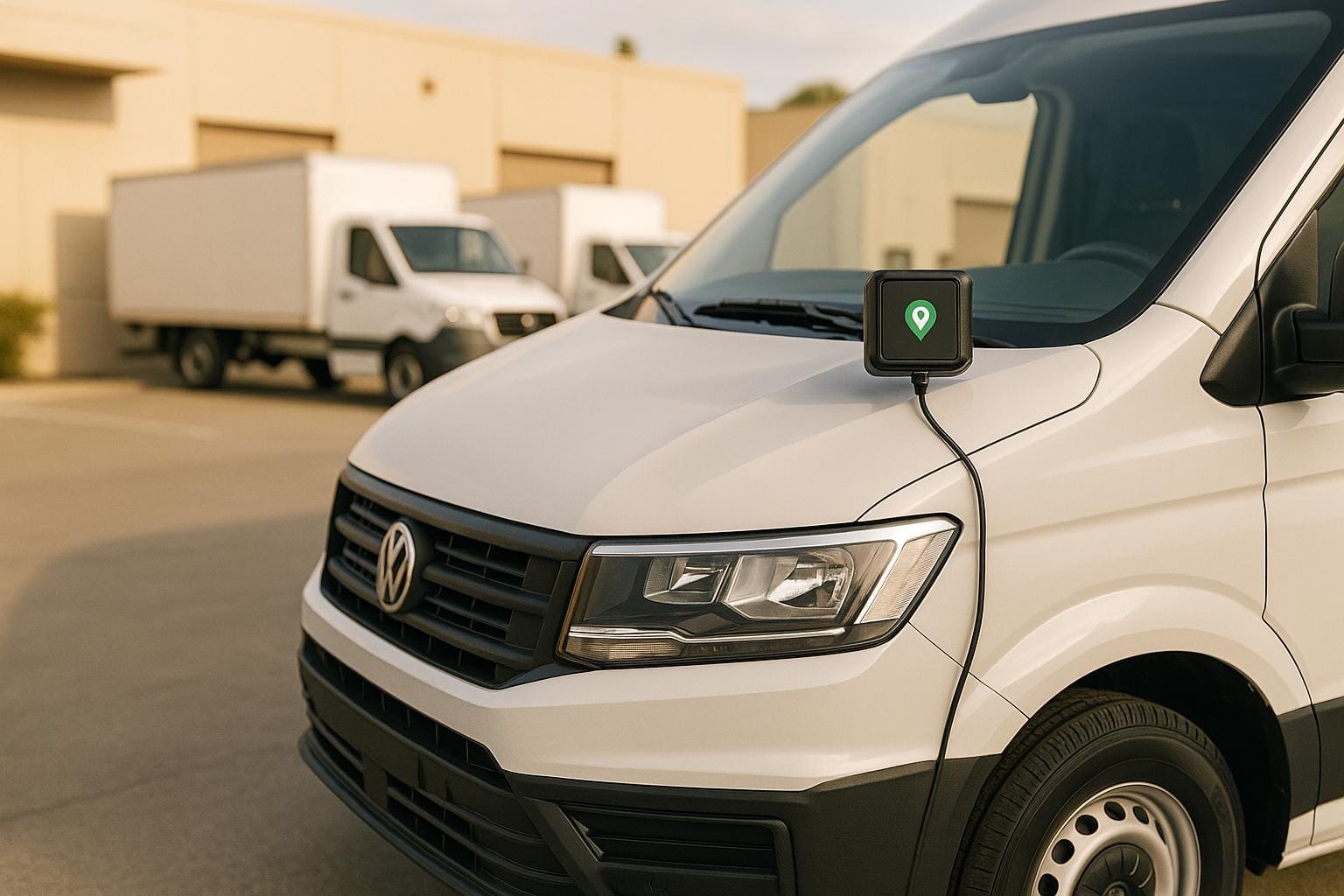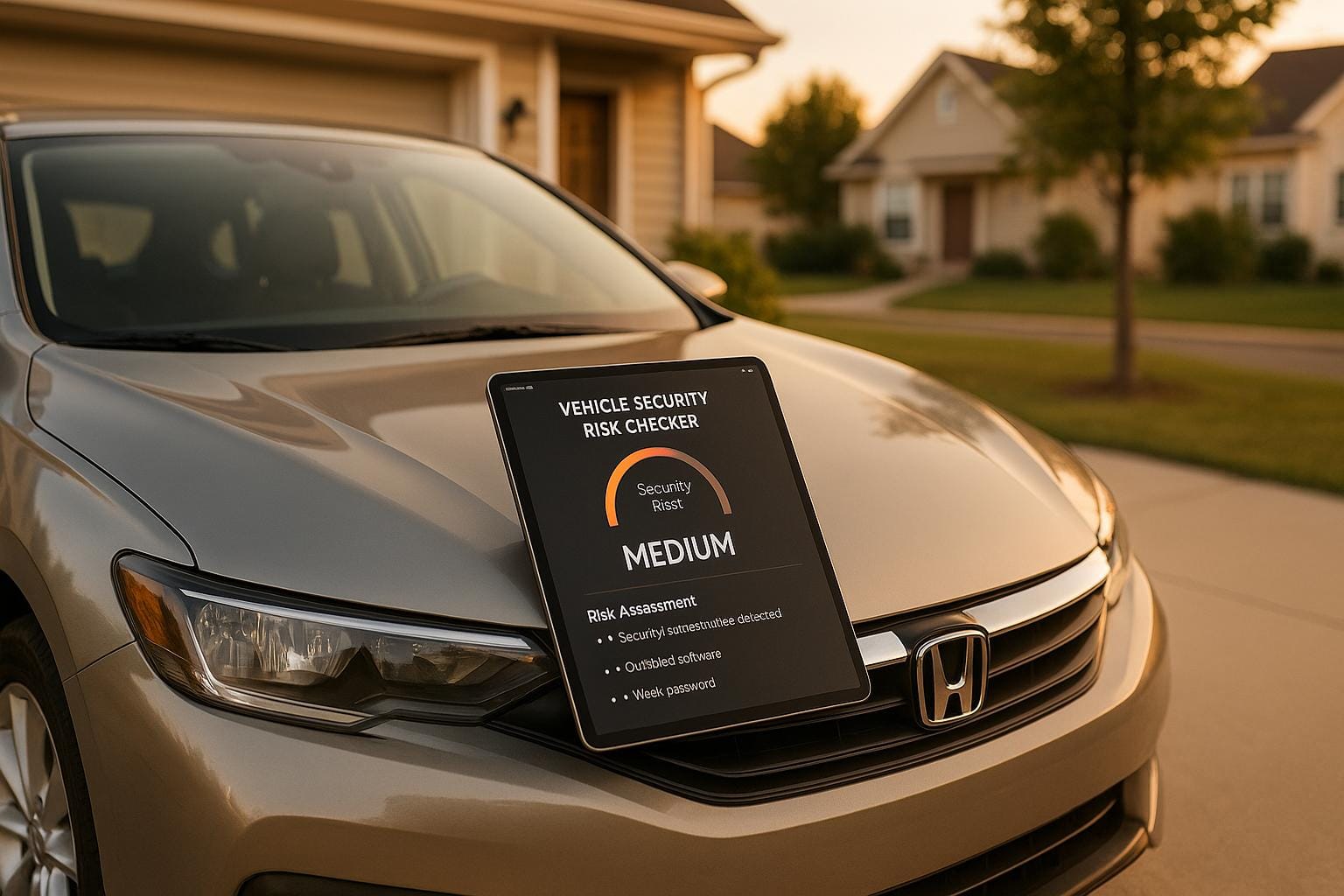Want to optimise your fleet operations while cutting costs? Start by tracking these 5 key metrics:
-
Asset Utilisation Rate
Measures how effectively your vehicles are used. Aim for 80% or higher to reduce idle assets and maximise revenue. -
Vehicle Idle Time
Tracks engine running time without movement. Reducing idle time can cut fuel costs by up to 25% and lower emissions. -
Fleet Capacity Usage
Ensures your fleet size matches operational needs. Avoid overcapacity or underutilisation to save costs and improve efficiency. -
Maintenance Schedule Compliance
Tracks timely completion of preventative maintenance. A 95% compliance rate can reduce breakdowns and improve vehicle lifespan. -
Fuel Consumption Per Mile
Identifies fuel inefficiencies and costly driving habits. Reducing fuel consumption by just 10% can increase profits by 31%.
Quick Benefits:
- Save on fuel, maintenance, and labour costs.
- Improve productivity and routing efficiency.
- Reduce emissions and meet sustainability goals.
Tracking these metrics isn’t just about cutting costs - it’s about improving overall fleet performance. Tools like GRS Fleet Telematics simplify data collection, helping you make smarter, data-driven decisions.
Ep 14 Fleet Management Metrics, KPIs all Fleet Managers Should be Tracking
1. Asset Utilisation Rate
The asset utilisation rate shows how effectively your fleet vehicles are being used over a set period. It’s calculated by comparing the time an asset is actively in use to the total time it’s available. For example, if a vehicle was available for 30 days in a month but only used for 15 days, the utilisation rate would be (15 ÷ 30) × 100 = 50%. This straightforward calculation provides valuable insight into how efficiently your operations are running.
By monitoring this metric, you can assess whether your fleet is being used to its full potential or if inefficiencies are inflating costs. These costs might include fuel, maintenance, and labour for vehicles that aren’t pulling their weight. Active time refers to any period a vehicle is in operation, while total available time includes all potential hours, accounting for maintenance and downtime.
Aiming for a utilisation rate of 80% or higher is a common goal for many organisations. Hitting this target suggests that your vehicles are contributing to revenue-generating activities rather than sitting idle while still accumulating costs like insurance, depreciation, and maintenance.
Improving utilisation isn’t just about efficiency - it can also lead to significant cost savings. Research shows that better utilisation can cut operational expenses by as much as 20%. Uneven usage across a fleet is a common issue, with some vehicles overworked while others are underused. This imbalance can cause premature wear and tear on certain vehicles and lead to unexpected breakdowns.
Tracking asset utilisation regularly allows you to identify underused vehicles and address inefficiencies in routing, scheduling, or job assignments. For instance, if certain regions or seasons consistently show low utilisation, it may be time to consider redeploying vehicles. Better utilisation also helps lower fuel consumption and emissions by reducing unnecessary idling and optimising travel distances, contributing to environmental goals. Additionally, it can guide decisions about replacing underused vehicles with electric or hybrid models.
To get the most out of this metric, set clear KPIs based on historical data and your operational needs, and review performance regularly. Advanced telematics systems - like those from GRS Fleet Telematics - can provide precise data to ensure your vehicles meet billable hour standards.
| Metric | Formula |
|---|---|
| Fleet asset utilisation (%) | (Total time asset is in use ÷ Total time asset is available) × 100 |
2. Vehicle Idle Time
Reducing idle time is one of the most effective ways to improve fleet efficiency and profitability. Idle time happens when a vehicle's engine is running, but the vehicle itself isn't moving. Even short periods of idling can rack up significant costs, impacting fuel expenses, maintenance budgets, and environmental goals.
The costs of idling are eye-opening. For instance, every hour of idle time burns about one gallon of fuel, and even 10 seconds of idling can consume more fuel than restarting the engine. A diesel truck idling for an hour typically uses 0.8 gallons of fuel and emits 18 pounds of CO2. In the United States, the average truck idles for about 1,000 hours annually. These numbers show just how crucial it is to tackle idle time before worrying about other efficiency metrics.
"Excessive driver idle time is often an overlooked cost driver in fleet operations. Reducing idle time is essential not just for cost management but also for promoting environmental responsibility."
– Sherry Calkins, Senior Vice President, Global Strategic Accounts at Geotab
For fleets in the UK, the financial impact is just as striking. Idling costs approximately £0.05 per minute. For a fleet of 200 vehicles idling 30 minutes daily, this adds up to nearly £110,000 wasted on fuel each year.
Reducing idle time can yield impressive savings. Cutting down on idling can reduce fuel costs by 15%, save around £1,500 per truck annually in maintenance, and even boost productivity by 25%.
Beyond cost savings, cutting idle time significantly reduces environmental harm. For example, a fleet of 25 trucks that trims idling by just 2 hours per vehicle daily can lower CO2 emissions by 106 metric tons annually. These reductions not only help companies meet sustainability goals but also slash operational costs.
Using GPS tracking and telematics systems is an excellent way to monitor and manage idle time. These tools provide detailed insights into idling patterns and fuel usage. For instance, GRS Fleet Telematics offers automatic alerts for excessive idling, enabling fleet managers to address problems as they happen rather than relying on delayed fuel consumption reports.
"GPS systems play a vital role in reducing idling because they provide fleet managers with the data they need to spot and train out such behaviour in drivers. Without this visibility, managers can't really do much."
– Adam Lang, director of customer advisory services at Netradyne
Driver training and reward programmes can also make a big difference. Educating drivers about how their habits impact the company’s bottom line encourages them to adopt more efficient practices.
Additionally, analysing idle time can improve route planning. By pinpointing areas where vehicles frequently idle - such as customer sites, loading docks, or traffic hotspots - fleet managers can adjust routes, schedules, or operations to keep engines from running unnecessarily.
| Impact Area | Potential Savings |
|---|---|
| Fuel costs | 15% reduction |
| Maintenance costs | £1,500 per truck annually |
| Productivity | 25% increase |
| CO₂ emissions | 106 metric tons per year (25 trucks) |
3. Fleet Capacity Usage
Fleet capacity usage gauges how well your fleet's total working capacity meets your daily operational demands. It's not just about counting vehicles - it's about determining if your fleet size aligns with what your workload actually requires.
Getting this balance right is vital. Too many vehicles can mean wasted money on insurance, maintenance, and registration. Too few, and you risk missed opportunities or dissatisfied customers. So, how do you measure this effectively?
Start by calculating capacity. Look at the total number of vehicles, the billable hours each vehicle works, and the number of working days per week. Factor in seasonal peaks and downtime for maintenance.
Fleet management software can simplify this process. Tools like GRS Fleet Telematics, popular in the UK, automate capacity tracking and provide real-time insights to optimise asset use. This data-driven approach not only improves accuracy but also helps cut costs significantly.
The financial impact of optimising your fleet is impressive. Fleets using GPS tracking systems have reported a 9% reduction in fuel costs, 15% lower accident costs, and a 10% decrease in labour costs. By adjusting your fleet size to match actual capacity needs, you avoid the expense of underutilised vehicles while ensuring you can meet customer demand. Pairing this metric with others like asset utilisation and idle time gives you a comprehensive view of efficiency.
Better capacity usage can also reveal inefficiencies in routing, scheduling, and vehicle assignments. For instance, underused vehicles can be reassigned to busier routes, boosting productivity without adding more resources. Consolidating lightly used vehicles during slow periods and reallocating them for peak demands can streamline operations even further.
Seasonal trends play a big role in capacity planning. For example, renting vehicles during busier periods might make more sense than permanently increasing your fleet size.
Regularly reviewing metrics like daily mileage and customer site visits is crucial. This data helps guide decisions about whether to buy, lease, or redeploy vehicles. The goal is to strike the perfect balance where your fleet size matches your operational needs.
Beyond cost savings, effective capacity management benefits the environment. Reducing fleet size by eliminating unnecessary vehicles cuts fuel consumption and emissions. When every vehicle has a clear purpose and operates efficiently, your environmental footprint shrinks considerably.
4. Maintenance Schedule Compliance
Keeping up with your fleet’s maintenance schedule is a critical measure of operational efficiency. This metric tracks the percentage of scheduled preventative maintenance tasks completed on time. By monitoring this, you can ensure your vehicles get the care they need, exactly when they need it. Aiming for a compliance rate of 95% is essential to maintain fleet reliability.
Industry standards recommend an 80% preventive maintenance to 20% corrective maintenance ratio. For example, in 2024, structured maintenance schedules led to a 21% reduction in fleet maintenance costs. This highlights how proper planning can directly lower operational expenses.
Paul Walker from Premier Fleet Services explains:
"A fleet that is well-maintained is a fleet that stays on the road... Fleet downtime leads to missed deliveries, higher costs and unnecessary compliance risks."
Automated fleet management systems play a vital role in maintaining compliance. These systems send real-time alerts and reminders, ensuring scheduled tasks are completed on time. By removing guesswork and reducing human error, automation helps keep your fleet running efficiently.
Regular servicing does more than prevent breakdowns - it also improves fuel efficiency and boosts resale values. Vehicles that are consistently maintained use less fuel and hold their value better, making timely servicing a smart investment.
The Car Care Council estimates that over £48 billion worth of vehicle maintenance goes undone annually. Emergency repairs, which are far more expensive than planned maintenance, can be avoided through compliance, helping to keep costs under control.
To stay on top of maintenance, use your fleet management system to schedule routine tasks like oil changes and tyre rotations. If delays or missed tasks occur, investigate the reasons immediately and adjust your schedules or resources as needed. Consistent maintenance compliance is a cornerstone of fleet optimisation, working in tandem with other efficiency metrics to enhance overall performance.
5. Fuel Consumption Per Mile
Keeping track of fuel consumption per mile offers a clear picture of which vehicles and drivers are pushing up fuel expenses. By comparing actual fuel usage to expected standards, this metric helps pinpoint inefficient vehicles and risky driving habits that may be costing more than you realise.
Driver behaviour plays a massive role in fuel efficiency. Research shows that driving habits can influence fuel consumption by as much as 37%. Aggressive actions like rapid acceleration and sudden braking can slash efficiency by 33% at motorway speeds. Even something as seemingly minor as driving 5 mph over 35 mph can lower efficiency by 5% to 10%.
Fleet management systems take this a step further by comparing each vehicle's fuel consumption to a database of similar models and years. This allows businesses to spot vehicles that might need repairs or drivers who could benefit from additional training.
"Understanding your fleet's fuel consumption can lead to major cost savings for your business." – Webfleet US
By combining monitoring tools with driver coaching, businesses can reduce fuel costs by up to 14%.
The financial implications are hard to ignore. Fuel often accounts for 38% of total fleet expenses. Refining efficiency practices can save businesses up to 10% on fuel costs. On top of that, cutting fuel consumption by just 1% can reduce CO₂ emissions by around 2.4 tonnes per vehicle each year. Since transportation is responsible for roughly 29% of greenhouse gas emissions, improving fleet efficiency also aligns with broader environmental goals.
To get the most out of this metric, set precise fuel benchmarks and focus on targeted driver coaching. Training drivers to adopt more efficient habits not only cuts costs but also reduces CO₂ emissions, making it a win-win for both the bottom line and the planet.
GRS Fleet Telematics offers cutting-edge tracking solutions to help you monitor fuel consumption in real time. Their telematics systems provide detailed insights into driver behaviour and vehicle performance, making it easier to spot areas for improvement. When combined with tools for asset utilisation and maintenance tracking, monitoring fuel consumption per mile becomes part of a well-rounded strategy to boost fleet performance.
Metric Comparison Table
Each metric offers distinct insights and challenges, helping you prioritise and implement them effectively. Here's a breakdown:
| Metric | Primary Benefits | Key Challenges | Best Applied When | Implementation Difficulty |
|---|---|---|---|---|
| Asset Utilisation Rate | Highlights underused vehicles, optimises fleet size, and cuts unnecessary purchases | Requires accurate tracking of billable vs. non-billable hours; seasonal variations can distort data | Ideal for fleet size decisions, budgeting, or identifying vehicles for disposal | Medium – consistent data tracking needed |
| Vehicle Idle Time | Cuts fuel costs by up to 25% and boosts driver accountability | Differentiating necessary from unnecessary idling; potential driver pushback on monitoring | Useful in high fuel cost scenarios, for meeting environmental requirements, or addressing driver behaviour issues | Low – easily tracked with telematics systems |
| Fleet Capacity Usage | Prevents over/under-capacity, improves customer service, and maximises revenue | Complex calculations, demand forecasting challenges, and balancing capacity with costs | Best for route optimisation or when expanding operations | High – requires advanced planning tools |
| Maintenance Schedule Compliance | Reduces breakdowns, extends vehicle life, and enhances safety | Aligning schedules with operations, managing costs, and finding reliable service providers | Key when downtime is high, safety concerns arise, or compliance is critical | Medium – needs strong scheduling systems |
| Fuel Consumption Per Mile | Delivers cost savings (10–20%), identifies inefficiencies, and supports sustainability goals | Impacted by driver behaviour, vehicle age, and route complexity | Valuable when fuel prices rise, sustainability is a priority, or driver training is in progress | Low – manageable with fuel cards and telematics |
These metrics provide a strategic overview to guide implementation. While all are essential, some are easier to adopt than others.
For instance, vehicle idle time and fuel consumption per mile are relatively simple to implement and deliver quick wins. Telematics systems can automatically track idle time, while fuel consumption is easily monitored through fuel cards. Businesses using GPS tracking often report fuel cost reductions of up to 25% and accident cost decreases of 17%.
Fleet capacity usage, on the other hand, is more complex to implement but offers substantial long-term benefits, particularly for growing businesses. Successfully managing this metric requires balancing demand forecasting, seasonal changes, and operational constraints.
Maintenance schedule compliance falls somewhere in the middle. While it demands robust scheduling, it's less challenging than capacity planning and still offers significant benefits like reducing breakdowns and improving safety.
The real value lies in combining these metrics. For example, a 10% drop in fuel consumption can lead to a 31% profit increase. When paired with improved asset utilisation and reduced idle time, the advantages multiply.
GRS Fleet Telematics systems simplify this process by capturing data for all five metrics in one platform. This integrated approach allows businesses to monitor and optimise fleet performance holistically, enabling smarter decisions and greater efficiency.
Conclusion
Tracking these key metrics transforms fleet management from a reactive process into a well-planned, strategic operation. For UK businesses, keeping an eye on these figures provides complete operational transparency, enabling smarter, data-driven decisions that lead to tangible results.
For instance, users of GPS tracking systems in the UK have reported impressive outcomes: a 25% average reduction in fuel costs, 17% fewer accident-related expenses, and a 20% cut in labour costs. Together, these savings can contribute to a 31% increase in profits, even with just a 10% reduction in fuel consumption. When these metrics are applied holistically across operations, the financial benefits multiply.
But it’s not just about cutting costs. These metrics also drive improvements in other areas. After implementing fleet tracking, 63% of UK businesses reported increased productivity, 59% noted better customer service, and 54% achieved more efficient routing. These gains extend further, enhancing compliance, safety, and even environmental responsibility. The knock-on effect? A more sustainable and efficient operation.
Take West Yorkshire Police as an example. By using telematics, they managed to reduce their fleet size by over 20% and cut mileage by more than 10%. This shows how systematic tracking can help organisations reduce waste without compromising service quality.
The environmental impact is equally significant. With transport contributing 27% of the UK’s total emissions in 2019, optimising fleets is vital for sustainability efforts. Businesses that monitor driver behaviour and optimise routes have managed to reduce fuel consumption and associated emissions by up to 10% through simple behavioural adjustments.
GRS Fleet Telematics makes tracking these metrics easier by consolidating all the data into a single, integrated platform. Starting at just £7.99 per month, it offers real-time tracking, driver behaviour analysis, and detailed analytics, making it accessible to UK businesses of all sizes. Its 91% recovery rate for stolen vehicles and dual-tracker technology further highlight its robust capabilities in improving fleet efficiency.
FAQs
How does tracking fleet utilisation metrics help businesses meet sustainability goals?
Tracking how a fleet is utilised is key for businesses working towards sustainability. By examining metrics like how often vehicles are in use, how much time they spend idling, and their fuel consumption, companies can spot inefficiencies. This insight allows them to make smarter decisions, improving operations while cutting down on fuel usage, emissions, and overall carbon footprint.
Keeping an eye on the use of eco-friendly vehicles also reveals ways to adopt greener strategies. With careful planning and smarter resource allocation, businesses can not only reduce their environmental impact but also save on operational costs. This approach strikes a balance between financial goals and sustainability efforts.
What features should I prioritise in a telematics system to monitor key fleet metrics effectively?
To keep tabs on essential fleet metrics like usage rates, idle time, and capacity planning, it's worth investing in a telematics system with real-time GPS tracking. This ensures precise location data and insights into how your vehicles are being utilised. Pair this with onboard diagnostics to keep an eye on vehicle health and engine performance. Add detailed reporting tools to evaluate driver behaviour, fuel consumption, and overall fleet efficiency.
Features like geo-fencing, real-time alerts, and driver scorecards can take things up a notch. These tools not only help cut down on idle time but also improve utilisation and simplify capacity planning. The result? A fleet that runs more efficiently and keeps costs in check.
How does staying on top of vehicle maintenance schedules improve fleet efficiency and reduce costs?
Keeping vehicles well-maintained on a regular schedule is key to keeping your fleet running smoothly. It reduces the chances of unexpected breakdowns, cuts down on downtime, and keeps operations moving efficiently. The result? More reliable vehicles and better overall productivity.
Staying on top of maintenance isn’t just about avoiding disruptions - it also saves money. By addressing small issues before they become costly repairs, you can extend the lifespan of your vehicles. A well-maintained fleet not only performs better but also helps you manage expenses more effectively over time.
